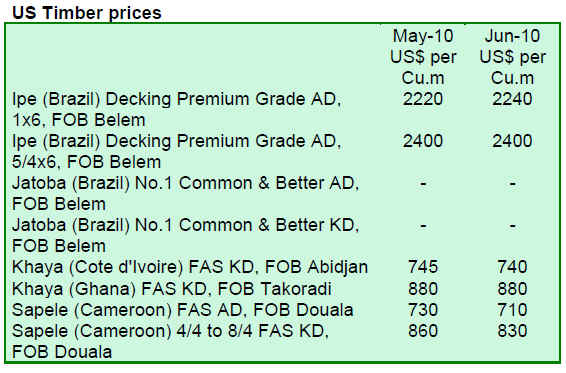|
Report
from
North America
Formaldehyde bill passed into law
President Barack Obama signed the Formaldehyde Standards for Composite Wood Products Act in July. This means that by January 1, 2013, hardwood plywood, particleboard and MDF sold in the US will have to meet a formaldehyde emission standard of about 0.09 parts per million. The regulation also applies to finished goods that are made from these composite wood products. Third-party testing and certification of compliance will be required.
The Environmental Protection Agency (EPA) has until July 2013 to revise import regulations to ensure that imported wood products comply with the standards. EPA will work with Customs and Border Protection and other agencies to enforce the new standards for imported wood products.
The nation-wide formaldehyde standards are modelled after the 2007 standards by the California Air Resources Board. Forest industry associations have welcomed the new legislation, including the International Wood Products Association who represents importers and distributors of wood products imported into the US.
LCA to help market American hardwoods worldwide
The American Hardwood Export Council (AHEC) is planning to have life cycle assessments (LCA) conducted for a range of American hardwoods species. It will be the most comprehensive LCA ever undertaken in the hardwood sector, according to Import/Export Wood Purchasing News.
AHEC is planning to use the LCA results in its marketing and lobbying activities. It will target public procurement officials in Europe, the Middle East, Australia and Japan as well as green building initiatives, architects and designers worldwide. US hardwood companies will also have access to the life cycle inventory data to create their own product-specific environmental profiles and marketing initiatives.
AHEC Executive Director Michael Snow describes the main objectives of the LCA initiative as follows:
• To fully exploit American hardwoods’ strong environmental profile;
• To counter the environmental claims of non-wood materials;
• To encourage a broadening in the scope of procurement policies;
• To ensure the environmental credentials of wood are given appropriate recognition in green building
initiatives;
• To counter-act an emerging tendency towards “localism”;
• To facilitate inclusion of wood products in UNFCCC national carbon accounts.
Furniture orders, shipments and retail
Residential furniture orders and shipments continued to improve. New orders for residential furniture increased 10% in May compared to the same month a year earlier, according to consulting firm Smith Leonard. Over 70% of the survey participants reported higher order rates year-to-date compared to the same period last year.
Furniture shipments also grew in May. Year-to-date furniture shipments were up 6% over May 2009. Backlogs increased from April as orders coming in to manufacturers were higher than shipments. Inventories increased in line with orders and shipments – up 4% over April levels.
However, the Furniture Buying Index declined in July after a steady increase over the past seven months. US consumers still worry about unemployment and spend less on big ticket items, according to America’s Research Group. The Furniture Buying Index is compiled each month by America's Research Group from interviews with 5,000-8,000 consumers across the country.
Furniture industry looking to recapture market share
The US furniture industry is in a good position to increase their share in the domestic market, according to an analysis by Hardwood Review Weekly. While the recovery from the recession is slower than expected, there have been shortages on the supply side.
In recent years, North American manufacturers aimed for low inventories to reduce cost and better compete with imported furniture. Production capacities were cut, especially when the recession hit. At the same time, wood furniture imports from China have dropped from $US7 billion in 2007 to US$5 billion in 2009. US anti-dumping duties on wood bedroom furniture from China and higher labour costs in China have contributed to the decline in furniture imports. Shipping cost and lead times have also increased for US hardwoods shipped to Asia for processing.
Consumer demand for furniture is only slowly recovering, but the North American industry is in a better position than in a long time to increase production and capture market share from offshore suppliers. A number of manufacturers have reopened plants, opened new ones or announced new investments, according to Hardwood Review Weekly.
US farm and forest products groups call for end of tropical deforestation
The National Farmers Union, the American Forest & Paper Association, the United Steelworkers (representing forest products workers), and the Ohio Corn Growers Association called for the protection of tropical forests as part of comprehensive energy and climate legislation and other policies.
According to Import/Export Wood Purchasing News, the farm and forest products groups are asking the US government to help end tropical deforestation citing the recently released report “Farms Here, Forests There: Tropical Deforestation and U.S. Competitiveness in Agriculture and Timber”. The report was commissioned by the National Farmers Union and Avoided Deforestation Partners. It reports that overseas agriculture and logging operations are expanding production by cutting down the world’s rainforests, allowing them to flood the world market with commodities that undercut American products. The report estimates that ending tropical deforestation will boost revenue of between US$196-$267 billion for US producers by 2030.

Related News:
|